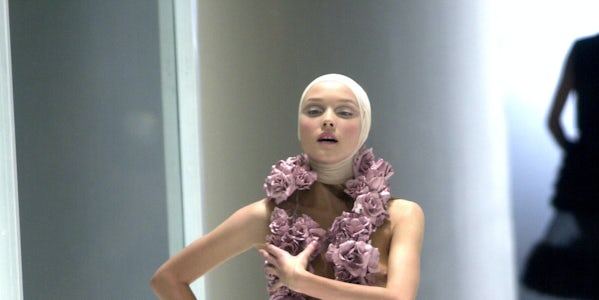How Sneakers Went From Hip-hop Status Symbol to Mass Market – WWD
PARIS — Having conquered the streets, the runways and high-fashion stores, the sneaker has landed at the museum, with an exhibition in Paris tracking the history of the world’s most democratic footwear.
“Sneakers, les baskets entrent au musée!” opened on Wednesday at the Musée de l’Homme, the Paris museum that focuses on the evolution of humans, with a display of more than 70 pairs of shoes, including a pair of Adidas sneakers signed by tennis legend Stan Smith himself.
But rather than appeal to sneakerheads with rare and unusual styles, Aurélie Clemente-Ruiz, head of exhibitions at the institution, wanted to explain the origins of the phenomenon that has swept the world, with 24 billion pairs now produced every year.
“Until quite recently, there were people who wore sneakers and belonged to a specific social group, and people who didn’t. Nowadays, everyone wears them,” she said. “It’s totally intergenerational and unisex. The democratization of sneakers means that today, it touches everyone on the planet.”
A vintage ad for Michelin rubber soles.
Courtesy of Musée de l’Homme
The exhibition, scheduled to run until July 25, begins with an early ad for French tire-maker Michelin, which continues to produce rubber shoe soles for brands including Under Armour and Camper. A glass case tracing the origin of the material features a pair of tiny 19th-century rubber shoes made in the Amazon.
“We wanted to talk about where they come from, why we wear them and what is the future of sneakers,” Clemente-Ruiz said. “We’re not a museum of fashion or design, so we wanted to focus on the historical and more technical dimension of the shoes.”
While U.S. brands like Converse, Keds and Spring Court were the first to offer sports shoes for the whole family, sneakers were popularized by athletes like French tennis player Suzanne Lenglen, who started wearing them in the 1920s.
The exhibition also features a pair of battered Puma sneakers signed by Serena Williams, a reminder of the U.S. tennis player’s early association with the brand, which has since been eclipsed by her partnership with Nike.
Through sports stars like Michael Jordan and his famed Air Jordan sneakers, launched in 1985, the style made the leap to the hip-hop community.
The exhibition features the cover of Run-DMC’s 1986 single “My Adidas” alongside a picture of the band posing in front of the Eiffel Tower, just a stone’s throw from the Musée de l’Homme, wearing three-stripe tracksuits and Superstar sneakers with the tongue pulled out.
After an executive from Adidas saw hundreds of fans waving their sneakers at a Run-DMC concert, the German sporting goods firm signed the group to a million-dollar endorsement deal, marking the beginning of its long-running affiliation with hip-hop.
“Starting from the United States, hip-hop culture spread worldwide, including Europe — and that’s how sneakers came to be worn massively by young people in Europe and namely in France, whereas before, it was really limited to athletes,” Clemente-Ruiz said.
The show spotlights one of the pioneers of the scene in France, Sidney Duteil, who became the first Black presenter on French television with a weekly show called “H.I.P. H.O.P.” on the TF1 channel. Guests included The Sugarhill Gang, Kurtis Blow and Afrika Bambaataa.
“At the time, it was revolutionary for a major French TV channel to broadcast a show dedicated to hip-hop culture, which was not at all a mainstream trend,” Clemente-Ruiz said. “It was important for us to talk about it, because he was largely responsible for introducing hip-hop to French households.”
The Balenciaga Triple S sneaker.
Courtesy Photo
By the late 1990s and early 2000s, sneakers had become objects of mass consumption. The exhibition highlights evergreen styles, from the Converse Chuck Taylor All Star to the Nike Air Force 1 and the Puma Speedcat, as well as recent high-fashion statements by designers such as Demna Gvasalia at Balenciaga and Virgil Abloh at Louis Vuitton.
Among the Balenciaga styles on display are its bestselling Triple S, the Track runner and the sock-like Speed Trainer. “There is a real element of rallying and social recognition around this brand in particular,” noted Clemente-Ruiz.
There are sections dedicated to collaborations, celebrity muses and counterfeits, the latter including a pair of fake Nike Mag Back to the Future sneakers seized by French customs, as well as silver Nike Dunk sneakers with high heels.
The exhibition also touches on innovation, ranging from 3D printing, with the made-to-measure Under Armour Architech from 2016; the Nike Air Zoom Alphafly, which shook up sporting competitions with its responsive carbon fiber plate and lightweight foam, and sustainable designs from brands like Veja and Le Coq Sportif.
It even broaches the topic of sneaker fetishism, including the practice of destroying sneakers, as evidenced by a pair of Stan Smiths that were cut up and then singed with a blowtorch. “There are also some people who get off on sniffing sneakers. To each their own kicks,” Clemente-Ruiz concluded.
SEE ALSO:
Poshmark Buys Sneaker Verification Firm Suede One
Recycled, Vegan Sneaker Collabs on the Rise
For Serious Sneaker Lovers, Luxury in a High-tech, Virtual Showroom







